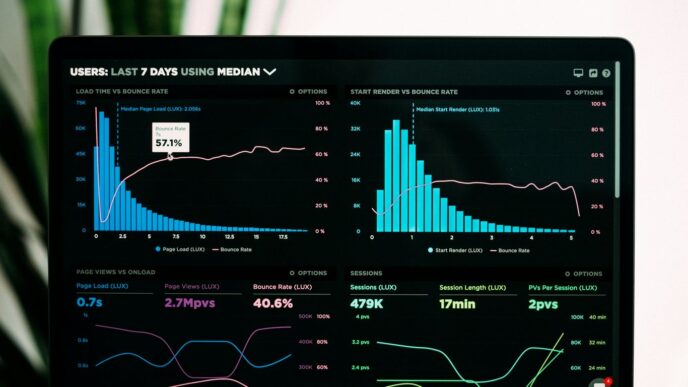Are your marketing campaigns falling short of expectations? A well-crafted marketing brief template might be the solution you need. This template serves as a guide to clarify your campaign’s goals and strategies, ensuring everyone on your team is aligned and focused. Let’s explore how a marketing brief template can help streamline your efforts and improve your results.
Key Takeaways
- A marketing brief template clarifies campaign objectives and strategies for your team.
- It enhances communication and collaboration among team members and departments.
- Using a template ensures consistency across different campaigns.
- It helps align all stakeholders toward common goals and expectations.
- A marketing brief is essential for adapting to market trends and understanding customer needs.
Understanding The Importance Of A Marketing Brief Template
Defining Campaign Objectives
Okay, so why bother with a marketing brief template? Well, think of it like this: you wouldn’t build a house without blueprints, right? Same goes for marketing. A marketing brief sets the stage for everything that follows. It’s about getting crystal clear on what you’re trying to achieve. Are you trying to boost brand awareness, drive sales, or launch a new product? Defining these objectives upfront keeps everyone focused and prevents wasted effort down the line. It’s easy to get lost in the weeds of tactics, but a solid brief keeps you anchored to the bigger picture. It helps you define the campaign objectives clearly.
Streamlining Team Communication
Ever been on a project where everyone seems to be on a different page? It’s a recipe for disaster. A marketing brief acts as a central source of truth, ensuring that everyone – from the creative team to the sales team – understands the goals, target audience, and key messages. This shared understanding minimizes confusion, reduces the risk of miscommunication, and promotes a more cohesive and efficient workflow. Think of it as a translator, making sure everyone speaks the same marketing language. It’s about making sure the left hand knows what the right hand is doing, which is surprisingly rare without a good brief.
Enhancing Collaboration Across Departments
Marketing doesn’t happen in a vacuum. It often involves multiple departments, each with its own priorities and perspectives. A well-crafted marketing brief facilitates collaboration by providing a common framework for discussion and decision-making. It helps to align different departments around a shared vision, ensuring that everyone is working towards the same goals. This cross-functional alignment can lead to more innovative and effective campaigns. It’s about breaking down silos and fostering a sense of shared ownership. Here’s how a marketing brief can help:
- Provides a single source of truth for all departments.
- Facilitates clear communication and shared understanding.
- Encourages collaboration and alignment around common goals.
- Reduces the risk of conflicting priorities and wasted effort.
Key Components Of A Marketing Brief Template
Campaign Purpose and Goals
Okay, so what’s the point of this whole thing? That’s what this section is all about. You need to nail down exactly what you’re trying to achieve with your campaign. Is it to launch a new product, boost brand awareness, or drive sales? Be specific. A vague goal is like trying to hit a target in the dark. Clearly defined goals are the foundation of a successful campaign. Here’s what you should include:
- A concise statement of the campaign’s primary objective.
- Specific, measurable, achievable, relevant, and time-bound (SMART) goals.
- Key performance indicators (KPIs) to track progress.
Target Audience Insights
Who are you trying to reach? You can’t just throw a message out there and hope it sticks. You need to know your audience inside and out. What are their demographics, interests, pain points, and buying behaviors? The more you know, the better you can tailor your message to digital marketing campaigns and connect with them on a personal level. Consider including:
- Demographic information (age, gender, location, income, education).
- Psychographic information (values, interests, lifestyle).
- Customer journey mapping to understand their experience.
Budget and Resource Allocation
How much money do you have to play with? And how are you going to spend it? This section outlines the financial resources available for the campaign and how they will be allocated across different activities. It’s not just about the total budget; it’s about making smart choices about where to invest your money. A well-defined budget ensures you don’t run out of steam halfway through. Here’s what to cover:
- Total campaign budget.
- Allocation of funds across different channels (e.g., advertising, content creation, social media).
- Contingency plan for unexpected expenses.
Here’s an example of how you might allocate your budget:
| Resource | Percentage of Budget | Amount |
|---|---|---|
| Advertising | 40% | $40,000 |
| Content Creation | 30% | $30,000 |
| Social Media | 20% | $20,000 |
| Contingency Fund | 10% | $10,000 |
Benefits Of Using A Marketing Brief Template
Improved Clarity and Focus
A marketing brief template really helps everyone stay focused. It’s easy for projects to drift, but a good brief keeps things on track. It’s like having a roadmap – you know where you’re going and how to get there. This is especially helpful when you’re dealing with complex campaigns that have a lot of moving parts. Plus, it makes it easier to say "no" to ideas that don’t fit the overall strategy. It’s all about staying laser-focused on what matters most.
Consistency Across Campaigns
Using a template means every campaign starts from the same place. This is great because:
- It makes it easier to compare results across different campaigns.
- New team members can quickly understand how things work.
- It reinforces your brand’s approach to marketing.
Think of it like having a standard operating procedure. You know what to expect, and you can easily spot any deviations. This consistency can save time and reduce errors, leading to better outcomes overall. It also helps in blogger outreach efforts.
Facilitating Stakeholder Alignment
Getting everyone on the same page can be tough, but a marketing brief template makes it easier. It provides a clear, concise overview of the campaign, so stakeholders know what’s happening and why. This can reduce misunderstandings and conflicts, and it helps build trust. When everyone is aligned, the campaign is more likely to succeed. It’s about creating a shared understanding and a common goal. Plus, it’s a great way to show stakeholders that you’ve thought things through and have a solid plan. This is especially important when you’re asking for budget or resources. A well-crafted brief can make all the difference in getting the support you need. It’s a key tool for effective collaboration and for keeping everyone aligned towards the common goal. A brief template helps your team understand who your audience is and how this audience can help achieve your campaign goals.
Creating An Effective Marketing Brief Template
Identifying Essential Information
Okay, so you want to make a marketing brief template that actually works? First, you gotta figure out what info is absolutely needed. Think of it like packing for a trip – what can’t you leave behind? For a marketing brief, that’s stuff like the campaign goals, who you’re trying to reach, what your budget is, and how you’ll measure success. Don’t get bogged down in details that don’t matter. Keep it lean and mean. A good way to start is by asking yourself, "If I only had one page to explain this campaign, what would I include?" That’ll help you focus on the [campaign’s purpose](#e021].
Structuring Your Template
Alright, you’ve got your essential info. Now, how do you put it all together? Structure is key. A disorganized brief is as good as no brief at all. I like to start with a summary at the top – a quick overview of the whole campaign. Then, break it down into sections: Objectives, Target Audience, Strategy, Budget, Timeline, and Measurement. Use headings and bullet points to make it easy to read. And for the love of all that is holy, use consistent formatting. Nobody wants to wade through a document that looks like it was thrown together by a toddler. Here’s a simple structure you can adapt:
- Campaign Title: Keep it short and memorable.
- Executive Summary: A brief overview of the campaign.
- Objectives: What are you trying to achieve?
- Target Audience: Who are you trying to reach?
- Strategy: How will you reach them?
- Budget: How much are you spending?
- Timeline: When will the campaign run?
- Measurement: How will you measure success?
Customizing For Your Brand
Don’t just grab a generic template and call it a day. Your marketing brief template should feel like your brand. Use your brand colors, fonts, and voice. Add your logo to the header. Include sections that are specific to your industry or company. For example, if you’re a fashion brand, you might want to include a section on visual style guidelines. If you’re a tech company, you might want to include a section on technical requirements. The point is, make it your own. A customized template will not only be more effective, but it’ll also reinforce your brand identity. Think of it as a [marketing campaign brief] that’s uniquely yours.
Examples Of Successful Marketing Brief Templates
It’s super helpful to see how other companies approach marketing briefs. Looking at examples can give you ideas for structuring your own and making sure you cover all the bases. Plus, it can spark some creativity!
HubSpot’s Campaign Brief
HubSpot is known for its marketing resources, and their campaign brief is no exception. It’s designed to be simple and capture the most important information without being overwhelming. It’s a great starting point if you’re new to briefs or want something easy to adapt. The template includes sections for campaign goals, target audience, messaging, and key performance indicators (KPIs). You can easily modify it to include additional information like campaign budget and metrics.
SmartSheet’s Marketing Brief
SmartSheet’s marketing brief is more detailed and focuses on project management. It’s useful if you need to track tasks, timelines, and resources within your brief. It’s especially good for larger campaigns with multiple moving parts. The template has space to define the campaign’s purpose, objective, target audience, resources, budget, marketing channels, goals, key takeaway, and more in order to supply clear expectations and direction before the launch of a marketing campaign.
Smart Insights’ Campaign Template
Smart Insights offers a campaign template that’s geared towards digital marketing. It includes sections for SEO, social media, email marketing, and content marketing. It’s a good choice if your campaign is primarily online. This template helps your team understand who your audience is and how this audience can help achieve your campaign goals.
Utilizing Your Marketing Brief Template

Okay, so you’ve got this awesome marketing brief template. Now what? It’s not just about filling it out once and forgetting about it. It’s about making it a living, breathing part of your campaign process. Think of it as your campaign’s North Star – always there to guide you.
Implementing Across Campaigns
Don’t just use your template for one-off projects. Make it standard practice for every campaign. Seriously. Big or small, new product launch or a simple social media push, use the template. This creates consistency and ensures everyone’s on the same page, every time. It also helps you build a library of past briefs, which can be super useful for future planning. You can see what worked, what didn’t, and adapt accordingly. Plus, it makes onboarding new team members way easier. They can just look at past briefs to get a feel for how things are done. Using a marketing campaign brief template consistently is key to success.
Training Your Team
Your fancy template is useless if your team doesn’t know how to use it. Take the time to train everyone on how to fill it out properly. Explain why each section is important and what kind of information you’re looking for. Hold workshops, create example briefs, and answer any questions. Make sure everyone understands that the brief isn’t just paperwork; it’s a tool to help them do their jobs better. Consider creating a quick-start guide or a video tutorial. The goal is to make the template as user-friendly as possible. You might even want to assign a "brief champion" – someone who’s really good at using the template and can help others.
Measuring Campaign Success
Your marketing brief isn’t just a pre-campaign document; it’s also a benchmark for measuring success. Before you even launch your campaign, you’ve outlined your goals and objectives in the brief. After the campaign is over, go back to the brief and see if you actually achieved those goals. Did you reach your target audience? Did you stay within budget? Did you get the results you were hoping for? Use this information to evaluate your campaign’s performance and identify areas for improvement. This feedback loop is crucial for refining your marketing strategy and making future campaigns even more effective. Think of it as a continuous learning process. Here’s a simple table to track your progress:
| Metric | Goal (from Brief) | Actual Result | Variance | Notes |
|---|---|---|---|---|
| Website Traffic | 10,000 visits | 8,000 visits | -2,000 | Need to improve SEO and promotion |
| Conversion Rate | 5% | 6% | +1% | Excellent! Keep up the good work! |
| Social Shares | 500 shares | 750 shares | +250 | Influencer marketing really paid off! |
The Role Of A Marketing Brief In E-commerce
Adapting To Market Trends
E-commerce moves fast. What’s hot today might be old news tomorrow. A marketing brief helps you stay agile. It forces you to consider current market trends and how your campaign will fit into the ever-changing landscape. Without a brief, you risk launching a campaign that’s already outdated or irrelevant. Think of it as your compass in the wild world of online retail. You need to constantly re-evaluate and adjust your course. A good brief allows for that flexibility.
Tailoring Messages For Customers
In e-commerce, generic marketing rarely works. Customers expect personalized experiences. A marketing brief makes you really think about your target audience. What are their needs? What are their pain points? What kind of language do they use? By answering these questions in your brief, you can craft messages that truly resonate with potential buyers. It’s about speaking directly to them, showing that you understand their unique situation. This level of personalization can significantly boost engagement and conversion rates. It’s not just about selling a product; it’s about building a connection.
Building Customer Loyalty
Customer loyalty is the holy grail of e-commerce. It’s far more cost-effective to retain existing customers than to acquire new ones. A marketing brief can play a key role in fostering loyalty. By clearly defining your brand values and consistently communicating them across all campaigns, you can create a strong sense of identity. Customers are more likely to stick with brands they trust and feel connected to. A well-defined brief also ensures that your campaigns are customer-centric, focusing on providing value and solving problems. This approach builds goodwill and encourages repeat purchases. Think of it as planting seeds for long-term relationships. Here are some ways to build customer loyalty:
- Personalized email marketing
- Exclusive loyalty programs
- Exceptional customer service
Wrapping It Up
In conclusion, using a marketing campaign brief template can really help you get your campaigns on the right track. We’ve talked about how to create one in five simple steps, starting with defining your campaign’s purpose and setting clear goals. Then, we looked at understanding your audience and crafting a solid marketing strategy. Finally, we emphasized the need for a realistic budget and timeline, plus how to measure success with KPIs. A well-structured brief not only keeps everyone aligned but also boosts your chances of hitting your targets. So, don’t skip this step—make a brief that works for you and watch your campaigns thrive.
Frequently Asked Questions
What is a marketing brief template?
A marketing brief template is a document that helps you plan and organize your marketing campaigns. It outlines the goals, strategies, and details needed to keep everyone on the same page.
Why is a marketing brief important?
A marketing brief is important because it helps clarify the campaign’s purpose and keeps the team focused. It ensures everyone understands their roles and what needs to be done.
What should be included in a marketing brief template?
A marketing brief template should include the campaign’s objectives, target audience, budget, and key messages. It should also outline who is responsible for each part of the campaign.
How can a marketing brief improve teamwork?
A marketing brief improves teamwork by providing a clear guide for everyone involved. It helps team members communicate better and work together more effectively.
Can I customize a marketing brief template?
Yes, you can and should customize a marketing brief template to fit your specific needs and goals. This makes it more relevant and useful for your campaigns.
How do I measure the success of a marketing campaign?
You can measure the success of a marketing campaign by setting clear goals and using key performance indicators (KPIs) to track progress. This can include sales numbers, website traffic, or social media engagement.














